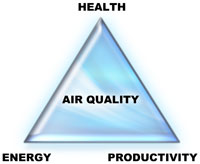Asbestos
Asbestos is a fibrous inorganic mineral material widely used in building and HVAC insulation and other building materials in the middle of the last century. It was banned in the 1970s, and intensive removal efforts have been made. About 20% of buildings in the US have some type of friable asbestos-containing material in them. A material containing asbestos is called friable when the material can be crumbled, pulverized, or reduced to a powder in the hand.
The U.S. Department of Health, Education and Welfare reported that in 20 U.S. cities, airborne asbestos concentrations ranged up to 0.007 fibres per cubic centimetre (fibres/cc) and averaged 0.0006 fibres/cc. The National Academy of Sciences concluded that the average outside air concentration throughout the United States is 0.0004 fibres/cc.
Asbestos causes asbestosis, or fibrosis of the lungs, sometimes leading to cancer. It also causes cancer of the larynx and is suspected of causing gastrointestinal cancer. People who have been exposed to high concentrations of asbestos fibres in the air generally run the highest risk of developing serious health disorders from their exposure.
Asbestos is generally not considered dangerous unless fibres of asbestos from the material containing the asbestos are released into the air. Dry applied materials are often in the category which can release fibres. In many cases, the asbestos is covered with a sealed covering to reduce or eliminate the release of fibres into the air.
